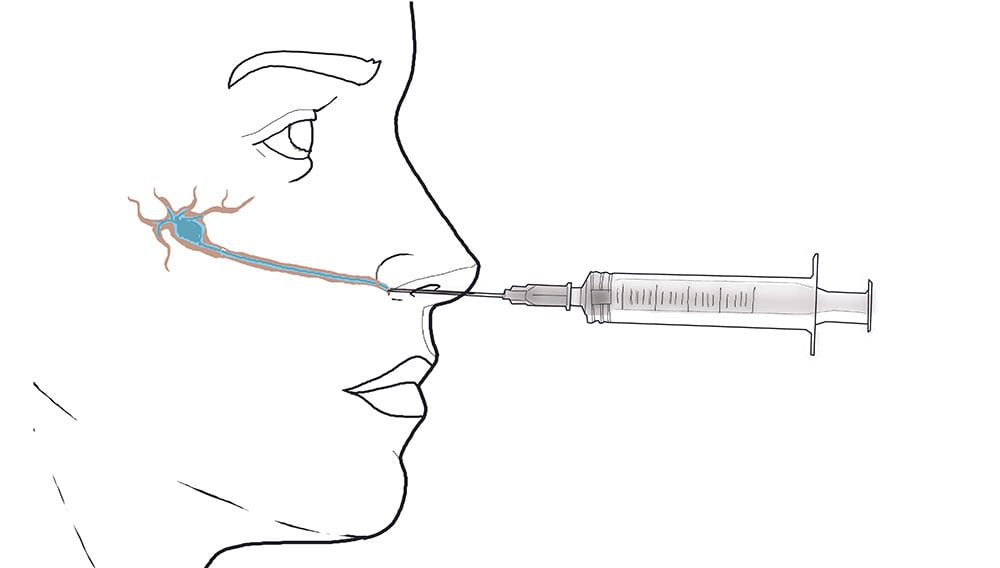Overview
The sphenopalatine ganglion is a small bundle of nerves located deep behind the nose. These nerves process various types of pain from the face. This type of nerve block is used to treat chronic pain in the face and can be used to treat certain types of headaches. Pain is lessened by blocking the pain signals from the sphenopalatine ganglion to the brain, reducing headaches and facial pain.

What conditions are treated with Sphenopalatine Nerve Blocks?
A sphenopalatine ganglion block is intended to treat different types of headaches and neuropathic pain syndrome. Types of headaches treated include migraines, post dural puncture headaches, cluster headaches, and post-traumatic headaches. Typically treated neuropathic pain syndrome includes atypical facial pain, trigeminal neuralgia, and sphenopalatine neuralgia.
How is the procedure performed?
Our team will help position you to make sure the procedure can be completed with the least amount of discomfort for you. There are two commonly used approaches that can be performed to complete this procedure. The first is intranasal (through the nose) the alternative is through the side of the face. Most commonly, your procedure will be done through the nose. X-ray can be used to identify precisely the target and then a long-stemmed cotton-tipped applicator dipped in numbing medicine will be placed into the nose and advanced under X-ray guidance until it reaches the sphenopalatine ganglion. This part can be uncomfortable but should not hurt. If your pain is on both sides, the same thing will be repeated in the other nostril. The cotton tip applicator is left in place for 30 minutes. During the entire procedure you will be constantly monitored by our team. After the injection a small bandage is placed on your skin. You will be given time after the procedure to make sure you feel good and are not having side-effects before leaving the clinic.
What medication is used?
The injection includes a combination of anesthetic (lidocaine or bupivacaine).
Does the procedure hurt?
The procedure is typically well tolerated. A localized burning sensation from the anesthetic is commonly felt and is usually the most uncomfortable part of the process. During the procedure a pressure sensation is often experienced this typically resolves within a few minutes. Minor soreness for a week after the procedure is normal.
How long does the procedure take?
The procedure typically takes about 30 minutes to perform. Please plan on being at the clinic for about 1 hour to allow for pre and post-procedural safety protocols.
How quickly will I get relief?
It can take up to a week to get maximal effect. Our team will follow-up with you and determine the need for any future injections.
How long can I expect the relief to last?
Every patient is different. Most patients get reduced pain lasting 2-4 months. Some patients can get relief lasting greater than a year.
How often can the procedure be repeated?
Depending on results and providers discretion the injections may be repeated up to 2-4 times per year for sustained pain relief.
What are the risks and side effects?
Risks and side effects are minimal and serious complications are rare. We take every precaution to ensure safety. Potential risks may include but are not limited to: vasovagal response (passing out), new or increased pain, infection, bleeding, permanent skin changes, allergic or unexpected drug reaction with minor or major consequences, and unintended nerve injury.
Pre-Procedure Information
Please let us know if you have an active infection, are using antibiotics, or are using blood thinners.
Should I take my normal medications as scheduled?
Yes. Continue taking your prescribed medications prior to procedure.
What if I am on a blood thinner or Aspirin?
Anticoagulation is often stopped for a short period of time prior to injection. Please speak with your primary physician if you take blood thinners to make sure that you can safely stop taking these medications.
Do I need a driver?
Yes. For your safety we require a driver to ensure safe return home.
Can I eat the day of the procedure?
It depends on the location. We recommend eating a light meal if the injection is done in our clinic. If the procedure is done at the surgery center then you must fast for at least 8 hours prior to the procedure.
Can I get sedation or anesthesia?
Most patients do well without sedation. Light sedation with oral medications is sometimes provided at the provider’s discretion.
What if I am pregnant?
There are serious potential risks to an unborn fetus when exposed to imaging studies, including x-ray and fluoroscopy. If there is any chance you may be pregnant, please postpone this procedure until it can be confirmed that you are not pregnant as it is not safe to do during pregnancy.
What should I wear?
We recommend light loose-fitting clothes. Sometimes we will ask you to change into a gown.
Post-Procedure Information
When can I drive after the procedure?
We recommend resuming driving the next day.
What can I do if I am sore or have pain after the procedure?
Ice packs can be applied to the area for 20 minutes per hour. Over the counter Tylenol and Motrin can be used to aid with any discomfort.
What are my restrictions after the procedure?
Typically, you may resume light activities on the same day following your procedure. Physical therapy can be re-started within 24 hours. We recommend returning to work the day after the procedure.
When can I shower?
Showering the day of the procedure is allowed. For 24 hours you are asked to refrain from submerging or swimming in water. Keep the bandage on for one day.
When do I come back for a follow-up visit?
We follow-up with all of our patients after their procedures. We typically see patients back in 2-4 weeks.
